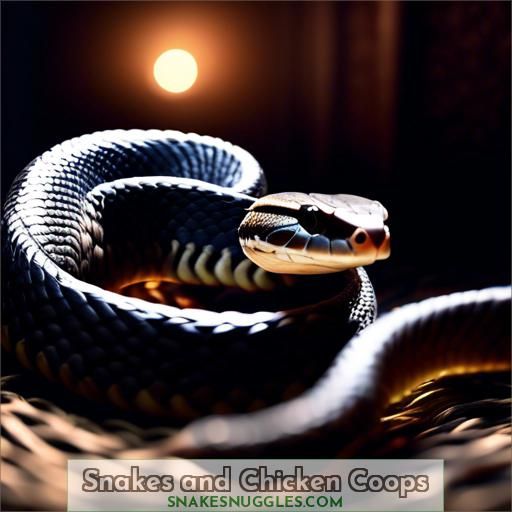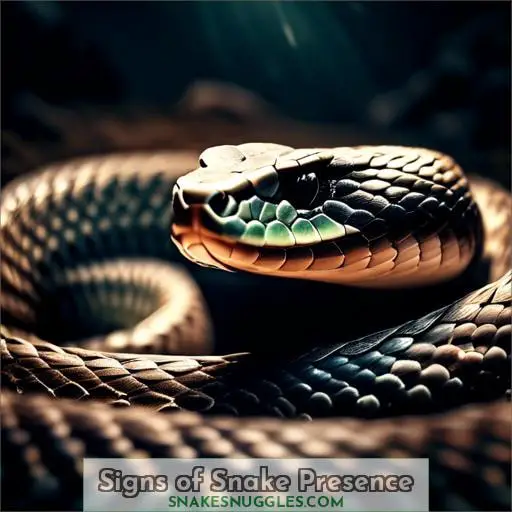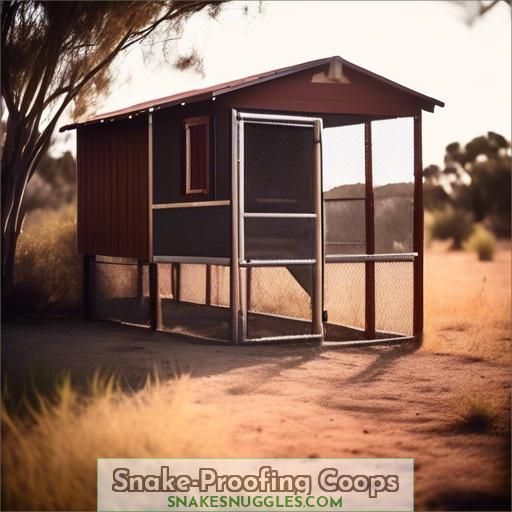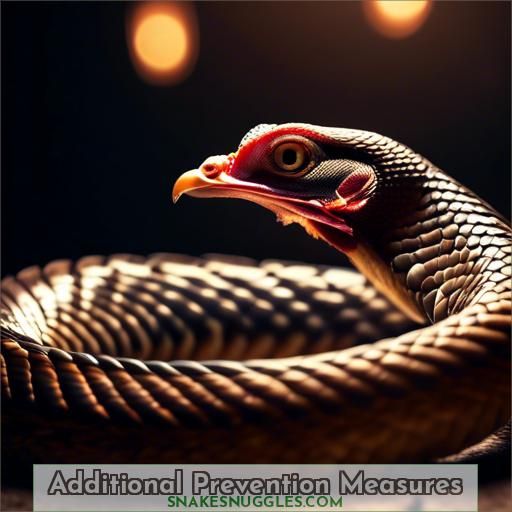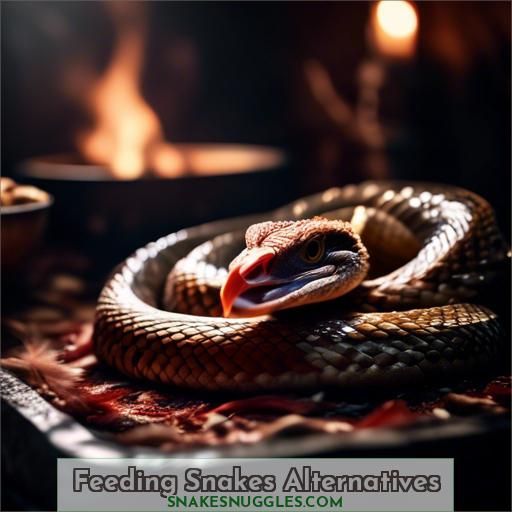This site is supported by our readers. We may earn a commission, at no cost to you, if you purchase through links.
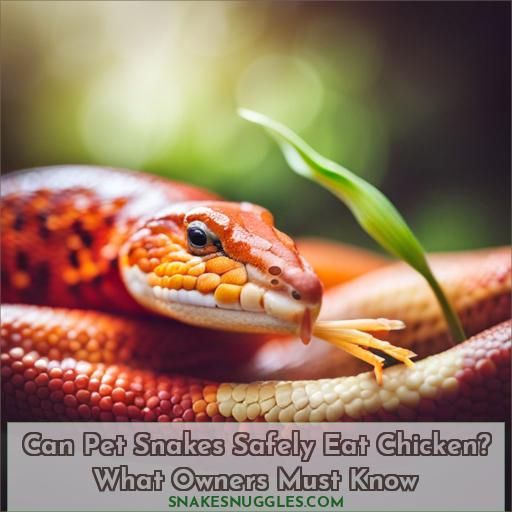 Yes, pet snakes can eat chicken, but it’s not their typical diet. While some snakes can be trained to accept chicken or fish as food, it’s time-consuming and not all will convert. When introducing new foods, understand the snake’s previous diet. Consider alternative prey like frozen rodents instead.
Yes, pet snakes can eat chicken, but it’s not their typical diet. While some snakes can be trained to accept chicken or fish as food, it’s time-consuming and not all will convert. When introducing new foods, understand the snake’s previous diet. Consider alternative prey like frozen rodents instead.
Snakes may enter chicken coops hunting eggs, chicks, or hens – posing a threat if venomous. To protect your flock, snake-proof the coop by raising the floor, using hardware cloth, clearing vegetation, and controlling rodents.
Want to learn more about safely feeding pet snakes and deterring them from chicken coops? Read on.
Table Of Contents
Key Takeaways
- Snakes typically don’t eat chicken or fish meat.
- Some snakes can be trained to eat dead food, including chicken or fish, but this process can be time-consuming and not all snakes will convert.
- To prevent snake entry into chicken coops, consider raising the floor, adding an apron, covering holes with hardware cloth, and clearing debris.
- Snakes are opportunistic predators that can pose a threat to chickens, especially venomous snakes, which can deliver fatal bites.
Can Pet Snakes Eat Chicken?
Yes, pet snakes can eat chicken, but it should be raw and not cooked or seasoned. Chicken is often used as a treat for snakes, and it is safe as long as you follow basic food safety guidelines. However, it should not be given regularly as it lacks essential nutrients like calcium.
Snakes can eat various parts of the chicken, such as hearts or other poultry parts, but they should not be given chicken breast too often.
Snakes and Chicken Coops
As a snake owner, you might be wondering whether your pet snake can eat chicken. Well, the answer is no. Snakes typically don’t eat chicken or fish meat. However, some snakes can be trained to eat dead food, including chicken or fish meat. But keep in mind that this process can be time-consuming and not all snakes will convert.
Now, let’s talk about snakes and chicken coops. Snakes can enter your coop for various reasons. They might be looking for food, such as eggs or chickens, or they could be seeking shelter, as coops often provide a warm, dry hiding environment. Venomous snakes can even pose a threat to your chickens, as their bites can be fatal.
To prevent snake entry, you can snake-proof your coop. Raise the floor to prevent digging, add an apron to deter burrowing, and cover holes with hardware cloth. Additionally, clear debris to eliminate hiding places, control rodents, and trap snakes using humane methods.
Snakes as Predators
As a snake owner, it’s crucial to understand the behavior of these creatures in relation to your chickens and their coop. Snakes are opportunistic predators, often entering chicken coops to hunt for eggs, chicks, and even adult chickens. While most snakes are too small to pose a threat to adults, venomous bites can be fatal.
Snakes are most active at night, making them more likely to be found in coops when the chickens are roosting. They may return daily for more prey, so it’s essential to take preventative measures to protect your chickens.
Signs of snake presence include missing chicks, reduced eggs in nests, regurgitated egg shells, and a dead chicken with a wet head. If you find a snake skin, it’s a clear indication that a snake has been in your coop.
To snake-proof your coop, raise the floor to prevent digging, add an apron to deter burrowing, and cover holes with hardware cloth. Additionally, clear debris to eliminate hiding places, control rodents, and trap snakes using humane cone or funnel traps.
While snakes typically don’t eat chicken or fish meat, some can be trained to eat dead food. However, this process can be time-consuming and not all snakes will convert.
Alternative options for pet reptiles include considering a different species with different dietary needs or researching the specific dietary requirements of any potential pet reptile before purchasing.
Signs of Snake Presence
Snakes are fascinating creatures, and their presence in your chicken coop can be a cause for concern.
- Missing chicks: If you notice that some chicks are missing, it could be a sign of a snake’s presence. Snakes are known to eat young chicks.
- Reduced eggs in nests: If you find fewer eggs in the nests than usual, it might be an indication that a snake is targeting the eggs.
- Regurgitated egg shells: If you see egg shells around the coop, it could be a sign that a snake has been feeding on the eggs.
- Dead chicken with a wet head: A dead chicken with a wet head could be a result of a venomous snake bite.
- Snake skins: If you find snake skins around the coop, it’s a clear sign that a snake has been there.
To prevent snakes from entering your chicken coop, consider the following measures:
- Raise the floor: By raising the floor of your coop, you can prevent snakes from digging underneath.
- Add an apron: An apron around the coop can deter burrowing snakes.
- Cover holes: Cover any holes or gaps in the coop with hardware cloth to prevent snakes from entering.
Additional prevention measures include:
- Clear out tall grass and bushes: Snakes may use tall grass and bushes as hiding places. Keeping these areas clear can help prevent snakes from entering your coop.
- Control rodents: Snakes are often attracted to rodents. By controlling rodent populations, you can reduce the likelihood of snakes entering your coop.
- Trap snakes: If you find a snake in your coop, consider using humane cone or funnel traps to relocate it. Always check for venomous snakes before handling.
Snake-Proofing Coops
Snake entry prevention is crucial for the safety and well-being of your chickens.
Coop design considerations play a significant role in keeping snakes out.
Raising the floor of the coop can prevent digging.
Adding an apron can deter burrowing.
Covering holes with hardware cloth can also be effective.
Additionally, clearing debris and controlling rodents can help reduce the likelihood of snake entry.
Rodent control strategies include trapping rats and mice, storing feed at night, and using treble or bucket feeders.
Predator deterrents like automatic coop doors can also be beneficial.
Coop maintenance practices, such as regular cleaning and inspections, can help identify and address potential entry points.
Additional Prevention Measures
When it comes to protecting your chicken coop from snakes, there are additional measures you can take to ensure the safety of your chickens. One of the most effective methods is rodent control. Snakes are often attracted to chicken coops due to the presence of rodents, which can be a food source for them. By controlling the rodent population, you can reduce the chances of snakes entering your coop. This can be achieved through trapping rats and mice, storing feed at night, and using treble or bucket feeders.
Another important aspect is the cleanliness of the coop. Clear debris and eliminate hiding places for snakes. Ensure that water dishes are always available and that the coop is kept clean to discourage snakes from entering. Raising the floor of the coop and adding an apron can also deter snakes from burrowing. Covering holes with hardware cloth can prevent snakes from entering through small openings.
If you find signs of snake presence, such as missing chicks, reduced eggs in nests, regurgitated egg shells, or dead chickens with wet heads, it’s important to take immediate action. Snakes can be dangerous predators, and it’s crucial to protect your chickens from their attacks.
Feeding Snakes Alternatives
When it comes to feeding your pet snake, it’s essential to consider the snake’s dietary needs and preferences. Although snakes typically don’t eat chicken or fish meat, some snakes can be trained to eat dead food, including chicken or fish. However, this process can be time-consuming and not all snakes will convert.
If you’re looking for alternative options for your pet reptile, consider the following:
- Understand the Snake’s Previous Diet: The snake’s previous diet should be considered when introducing new foods. Snakes that have been eating live mice may be reluctant to switch to dead food.
- Consider Alternative Prey: Dead or frozen food is a viable option for some snakes. Research the specific dietary requirements of your pet reptile to determine the best alternative prey.
- Explore Different Reptile Species: Consider getting a different type of reptile that doesn’t eat mice. Other reptiles may have different dietary needs that are easier to meet.
- Research Dietary Requirements: Before purchasing a new pet reptile, research its dietary requirements to ensure you can meet them.
In the realm of reptile care, understanding and navigating the complexities of snake diet can be daunting. It’s not merely about providing food; it’s about providing the right food. Our suite of products is designed to enhance your experience and understanding of pet reptile care. It’s advisable to seek more than just the basics when it comes to caring for your pet snake.
Frequently Asked Questions (FAQs)
Can pet snakes eat chicken meat?
Yes, some pet snakes can eat chicken meat, though it may take time to transition them. Start by offering small portions alongside their usual prey items. Be patient and consistent – snakes have specific dietary needs, so monitor closely for acceptance.
How to train snakes to eat dead food?
Picture a snake charmer gently coaxing a stubborn reptile onto new terrain. With patience and persuasion, you’ll transition your scaly pal to enjoy fresh fare.
What snakes eat chicken and fish meat?
Most snakes won’t eat chicken or fish. Their instincts drive them to hunt live prey like rodents. While some constrictors could be trained to accept prepared meats, it’s an uphill battle against their hardwired hunting behaviors.
Alternative reptiles for snake owners?
You’re seeking an engaging reptilian companion? Consider a bearded dragon or crested gecko – these charismatic creatures offer unique personalities without the dietary demands of snakes. Explore the captivating world of alternative reptile pets!
How to switch snakes from live to dead food?
You’ve got this! Gradually introduce dead prey by leaving it next to a live one. Stay patient – it may take time for your snake to accept the change. Withholding food for a week can help encourage acceptance too. Consistency and positive reinforcement are key.
Conclusion
As guardians of the coop, you’ve donned the mantle of protector, shielding your feathered friends from slithery threats. The snake’s hunger for chicken is undeniable, but with vigilance and preventative measures, you can keep your flock safe. Remember, offering snakes appropriate alternative prey not only satisfies their cravings but also maintains the delicate balance of nature’s food chain.

